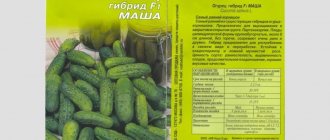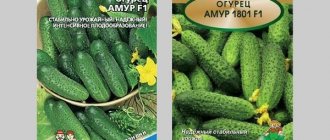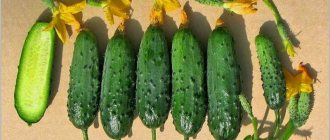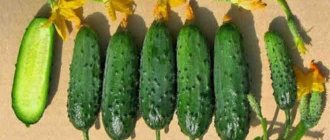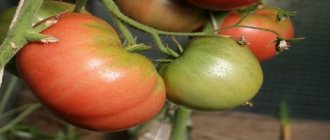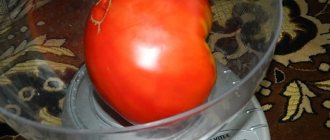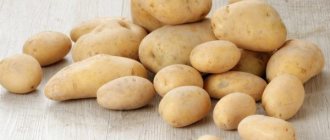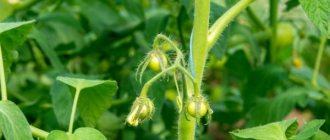Characteristics and description of the cucumber variety Furor F1
Cucumber Furor F1 is a hybrid bred by Russian breeders, the agricultural company Partner. The variety has not yet been included in the State Register, but an application has been submitted, and the conclusion will be announced after testing and studying the hybrid.
Variety Furor F1 is a parthenocarpic, early-ripening hybrid. From the moment of seed germination to harvest, no more than 40 days. The plant forms a powerful, tall bush with well-developed roots. Furor F1 grows quickly in greenhouse conditions. The height of the main shoot is about 3 m, the side shoots are short and densely leafy.
Description of the appearance of plants
And especially for the shooting, I left slightly overgrown cucumbers, although they are absolutely within the standard that describes the variety. Very beautiful shape and coloring. You take a cucumber in your hand and feel the heaviness. This means there is no emptiness in the cucumber. This is a bunch, that is, 2-4 cucumbers are formed in each sinus. All the cucumbers that appear will definitely develop and bear fruit. They will not fall away from any troubles in life.
The plant has a considerable height; it can grow somewhere on the order of 3 m or even more. Therefore, I think that this hybrid is interesting not only for garden plots of six hundred square meters, but is also interesting for the mass production of these products.
I wanted to show you what this Furor cucumber actually is. For the future, know that you need to step back at least 5 millimeters from the knot so that the tip remains small.
Taste qualities of cucumbers
The type of fruiting in the Furor F1 hybrid is bunched. Up to 5 greens ripen in the leaf axil. Cylindrical cucumbers ripen small, 12 cm long, weighing up to 80 g. The fruits are covered with a dark green, thin, elastic peel with small tubercles.
The pulp is juicy, dense, fragrant, and does not form voids. The taste is sweet, without signs of bitterness. The seed chambers are small in size, the seeds are colorless, as they are in milky ripeness. Furor F1 is a universal hybrid. The fruits are consumed directly from the garden, for preparing vegetable salads and winter preservation.
Important! Furor F1 cucumbers have good transportability and keeping quality. Even after long-term transportation, the crop does not deform or turn yellow.
Agricultural technology
In order for the variety to form an early harvest, it must be grown in seedlings. The planting time is calculated taking into account the rapid growth of the crop; Furor seeds are sown approximately 25 days before the intended transplant. Seedlings that appear in insufficient light must be illuminated and kept at a temperature not lower than +27°C. After the appearance of side shoots, the temperature is lowered to +18°C or +23°C, watering is carried out only with warm water, you can spray it from a spray bottle. Seedlings ready for transplanting must have at least 6 true leaves. The recommended planting density is 3 - 4 pieces per 1 square meter. The soil must be nutritious, moisture- and breathable. A few days after transplantation, the bushes are tied to a trellis. At a height of 80 cm from the soil surface, all side shoots of the cucumber can be removed. On the remaining shoots, you need to preserve the ovary that appears in the axil of the first leaf, and then, after 2 or 3 leaves, limit the growth of the shoot. Care is simple - the plant needs to be provided with good watering and fertilizing. It is also necessary to carry out weeding and loosening.
Furor, or Furo, showed very impressive results during test cultivation. Resistance to diseases, excellent productivity and the continuous process of fruit formation during the growing season make the variety interesting not only for growing on private farms, but also on an industrial scale. Despite the fact that the variety is new, no shortcomings have been identified in the process of its cultivation. But vegetable growers will have to purchase cucumber seeds annually.
Many people love fresh, crispy cucumbers, especially if they are grown with love and in their own garden. There are a lot of varieties, they differ in size, ripening period and taste. The Furor F1 cucumber is considered one of the best early ripening hybrids. To grow a decent harvest, you need to study the description and reviews of Furor F1 cucumbers.
Growing cucumbers Furor F1
To get a harvest in 40 days, it is necessary to carry out timely planting. Cucumbers are susceptible to cold, so producers advise growing the variety under film cover or sowing Furor F1 cucumber seeds in open beds only after the soil has warmed to + 15 °C.
Planting seedlings
To harvest early harvest, it is better to grow cucumbers through seedlings. Seeds are sown 30 days before planting in a permanent place. For this:
- The seeds are soaked for 20 minutes in a growth stimulator.
- The cups are filled with nutritious soil.
- The seed is buried 2 cm.
- To obtain early shoots, the seeds need to create greenhouse conditions.
- After germination, the containers are moved to the brightest place.
- At the age of 4 weeks, when 5 true leaves have formed, the plant can be transplanted to a permanent location. The planting density of the Furor F1 hybrid is 4 plants per 1 sq. m.
Important! Good growth, development and productivity are influenced by compliance with crop rotation. Cucumbers grow well after tomatoes, cabbage, garlic and onions. It is not recommended to plant cucumbers after zucchini, pumpkin and watermelon.
Landing in the ground
Hybrid Furor F1 prefers to grow in a sunny area. Before the shoots appear, a trellis must be installed: metal arcs, mesh or wooden frame. The shoots will rise along them as they grow, thereby facilitating care and harvesting.
Planting seeds in open ground is carried out after the end of spring frosts. Since cucumbers grow well and bear fruit in nutritious soil, the bed is dug up and manure or rotted compost is added. In a prepared, moistened bed, make rows 2-3 cm deep, plant the seeds at a distance of 30 cm, sprinkle with soil and mulch the soil.
Advice! When growing cucumbers in regions with an unstable climate, the planting material is covered with agrofibre before emergence.
Watering and fertilizing
Watering is carried out as the soil dries out. For each plant, 5 liters of warm water are used to moisten the soil to a depth of 25 cm. After irrigation, the row spacing is loosened and mulched. Mulch will conserve moisture, stop the growth of weeds, and act as an additional fertilizer.
Advice! At the beginning of flowering, loosening is stopped and watering is increased.
At the beginning of summer, cucumber bushes are fed with mullein at a rate of 1:10. 3 liters of fertilizer are poured under each plant. At the beginning of fruiting, phosphorus-potassium fertilizing is carried out, diluted strictly according to the instructions. The interval between applying fertilizer should be at least 1 month. Fertilizing is applied in the morning or evening, only after abundant irrigation.
Formation
To get a rich harvest, the cucumber bush must be properly formed. At a height of 30 cm, all side shoots are removed. It is also necessary to remove all flowers and ovaries up to the 5th leaf. Next, the plant is formed; for this purpose, 6 lateral shoots 30 cm long are left. When they grow to half a meter, the top is pinched. After the main stem reaches 3 m, the growth of the plant is limited.
Protection from diseases and pests
As the description, photos and reviews from gardeners show, the Furor F1 cucumber has strong immunity to many diseases. But often insect pests settle on the plant if the care rules are not followed. These include:
- Aphids – often appear in mid-summer. If not treated promptly, aphids can destroy the entire plant. You can help a cucumber by treating it with onion or garlic, alkaline infusion.
- Spider mites - often appear on cucumbers grown in a greenhouse. To combat the pest, a soap solution or store-bought product will help.
- Root-knot nematode is a pest that attacks the root system. When a disease is detected, about half a meter of affected soil is removed, replacing it with healthy soil.
Landing technology
To cultivate this hybrid, both seeds and seedlings are used. Let's consider each planting method separately.
Planting seeds in the ground
First, cucumber seeds are pickled in a strong solution of potassium permanganate for 20 minutes and washed with warm water. Afterwards they are wrapped in damp gauze and placed in a warm place in the light. For 1-2 days, while the seeds germinate, the gauze is kept moist.
Hatched specimens are sown in beds (to a depth of 5-7 cm) at a distance of approximately 40-50 cm from each other, covered with soil and carefully watered.
When planting indoors, it must be taken into account that the soil must be warmed to at least 15°C. Lighting plays a huge role: for year-round cultivation, special lamps must be used for normal germination and active growth. Air humidity must be at least 27°C.
Growing seedlings
The seed material is first pickled in a solution of potassium permanganate and washed. Plant one at a time in peat cups, 2/3 filled with soil for growing seedlings. Embedment depth – 1.5-2 cm.
- Until the shoots appear, the cups are kept in a warm place in the light. Then light is needed.
- Daylight hours should be at least 12-15 hours, and the first week requires round-the-clock lighting (use backlighting).
- Air temperature is 18°C during the day and 15°C at night. In the second week it is increased to 20-25°C.
Plant productivity depends on proper care
Cucumber seedlings are planted in the ground when 5-6 full-fledged leaves are formed on it. Plant directly in peat cups - they should be covered with 0.5-1 cm of soil. Water well.
Planting plants in a heated greenhouse usually begins in February. The number of copies per m² is 3-4. When the seedlings begin to grow, they must be tied to a trellis.
Productivity
Furor F1 is a high-yielding hybrid. Due to the tall growth and bunch type of fruiting, with proper care from 1 sq. m you can collect up to 18 kg of greens. Harvesting is carried out several times a week, but thanks to the varietal characteristics, ripe cucumbers do not outgrow or overripe. Due to its high yield, the hybrid can be grown on an industrial scale.
The variety does not require pollination, so it can be planted both in open beds and under film cover. Regardless of weather conditions and pollinating insects, the hybrid will bear fruit abundantly throughout the growing season.
Care during cultivation
Care involves regular watering, loosening, weeding and effective pest control of vegetable crops.
Watering
The optimal watering regime is 1-2 times a week, depending on the weather and soil type. Since the root system is well developed, the soil is moistened to a depth of 25 cm. It is best to take warm rain or settled tap water.
For irrigation, use a watering can or a watering hose with a “water shower” type sprayer.
Top dressing
You can feed with both organic and mineral fertilizers. The procedure is best done in the evening. Bring it into the root zone, trying not to get it on the leaves. The first time each cucumber is fed 2 weeks after planting the seedlings in the ground.
The further schedule is drawn up based on the recommendations proposed by the manufacturer of a particular fertilizer. Organic fertilizers are applied 2-4 times during the season.
Weeding
Weeds are removed immediately. The soil is loosened very carefully and only before flowering begins, and then after fruiting begins.
If necessary, the beds are thinned out: the optimal distance between the shoots of the bushes is 7-10 cm, and between the bushes themselves - at least 60.
To ensure access to light to the ovaries, on adult bushes, side shoots growing at a height below 50 cm are removed. It is advisable to pinch out the remaining shoots after the 3rd leaf.
Pest treatment
According to the characteristics, this cucumber is most often damaged:
- spider mite;
- root-knot nematode;
- aphids.
Spider mites are destroyed with certain drugs or a solution of laundry soap. The root-knot nematode is the most unpleasant “cucumber enemy”. It is very difficult to get rid of it: you need to completely remove a layer of soil 50 cm thick and fill in a new one instead.
Therefore, the best option is preventive measures. These include:
- steam treatment of soil;
- soil freezing (winter);
- purchasing quality planting material.
Aphids can completely destroy plants. The best method of control is with ladybugs. They are collected by hand or lured to the site by planting dill or mustard between the cucumber beds.
In the greenhouse, both damaged and healthy plants are treated with tobacco dust, sprayed with a solution of laundry soap with natural tobacco, as well as garlic tincture.
Pest treatment
Cucumber Furor suffers from a number of pests:
Appears in July and August. A large number of pests on the leaves leads to the death of the plant. Ladybugs, which are attracted with dill or mustard greens, help fight them. Cucumbers are also treated against aphids with an infusion of onion or garlic or an infusion of tobacco with the addition of laundry soap.
Spider mite
This parasite infects plants in greenhouses. To combat it, store-bought remedies are most often used. A soap solution also helps.
Everyone loves fresh, fragrant, crispy cucumbers. And it is desirable that they also ripen earlier. These are the requirements, according to consumers, that a cucumber should meet. But the breeders put into the Furor variety, which will be discussed, some more characteristics that experienced vegetable growers will definitely appreciate. The variety appeared on the seed market not long ago, so there is not much official information about it. It is not yet listed in the State Register of Breeding Achievements of Russia, but an application for its inclusion has been submitted, although for registration the originators (agro) slightly changed the name to “Furo”. The best performance during testing of the new product was demonstrated in a greenhouse, but in open ground the result was no less remarkable. Furor is a hybrid and is therefore labeled F1.
Diseases and pests
“Furor” is not susceptible to olive spot, powdery mildew, or common mosaic virus. However, when growing in cool and damp climates, the risk of infection increases. Preventive measures include compliance with agrotechnical rules, ventilation of greenhouse structures, and thickening of plantings during planting should also be avoided. If a disease is detected, the plant is treated with Topaz or Fundazol. Re-process after a week. As a preventative measure, plantings are sprayed with a solution of iodine or wood ash.
In the fight against common pests (aphids, spider mites, root-knot nematodes), they resort to traditional methods or the use of insecticides.
Advantages and disadvantages
Hybrid "Furor" is characterized by the following advantages:
- Long-term fruiting;
- Precocity;
- Resistant to adverse conditions;
- Lack of bitterness in greens;
- Immunity to many diseases;
- Ability for long-term storage;
- Excellent transportability;
- Product appearance;
- Excellent pickling qualities.
Despite its relatively recent appearance, no shortcomings were identified in the hybrid.
Harvest and storage
The fruits of cucumbers of this variety are harvested regularly as they ripen, when they reach a size of 10–12 cm. The collection frequency is usually once every 1-2 days. During the period of mass fruiting, the beds are inspected twice a day - morning and evening.
Cucumbers are removed from the bush by twisting. Moreover, not only ripe specimens should be removed, but also damaged or irregularly shaped ones. This is done so that low-quality fruits do not weaken the bush. During harvesting, you should not tug or pull the cucumber vines too much.
The picked fruits are stored in the refrigerator in the vegetable compartment. Their shelf life is 1-2 weeks. If you follow all the growing recommendations, the Furor cucumber will certainly delight you with fresh, crisp fruits throughout its long fruiting period. The main thing is to choose a place for planting well and properly care for the plants.
Detailed description of the fruits
The Furor F1 variety produces medium-sized, one-dimensional, even fruits. There are small tubercles and whitish pubescence on the surface.
According to the description, reviews and photos, Furor cucumbers have a number of features:
- cylindrical shape;
- length up to 12 cm;
- diameter 3 cm;
- weight from 60 to 80 g;
- rich green color, no stripes.
The pulp of the fruits of the Furor F1 variety is juicy, tender, quite dense, without voids. The aroma is typical of fresh cucumbers. The taste is pleasant sweet, there is no bitterness. The seed chambers are average. Inside there are unripe seeds that are not felt during consumption.
Furor F1 cucumbers have a universal purpose. They are eaten fresh, added to salads, vegetable cuts, and snacks. Due to their small size, the fruits are suitable for canning, pickling and other homemade preparations.
